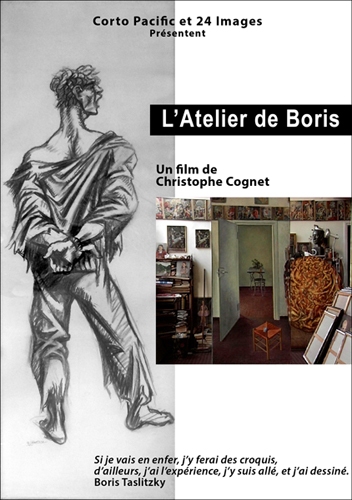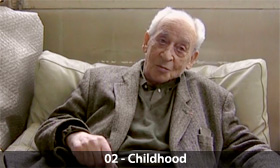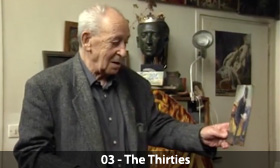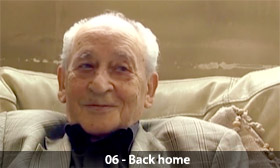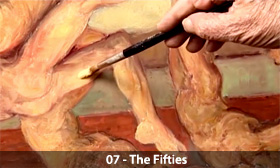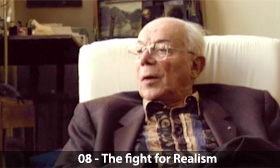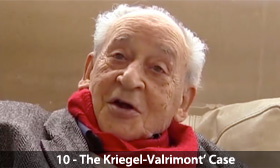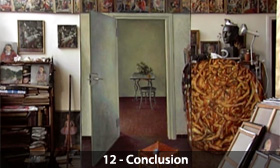
FULL-LENGTH MOVIE
By clicking on this picture, you can watch the whole movie (1h 34min).
CHAPTERS
To watch chapters, click the thumbnails.
THE WORLD TOUR 
It was an artist's studio in the heart of the thirteenth Parisian district, where this straight man, barely bent by the weight of years, painted intertwined and flamboyant bodies on a round canvas - a tondo..
The walls of the studio were covered with paintings: still lifes, portraits, crowds, historical subjects, landscapes ...
His workspace, with years, had been reduced by the 800 paintings placed on the floor, on the slice as it should be. The frames were classified by decreasing size to the smallest pochades, which were the only one exposed to the gaze.
It was a world in itself.
I came here thanks to my friends, Nadine and Michel Suret-Canale, who had told me about Boris so often. The idea of making a film about his life appeared to us obvious. Nadine was going to help me - she knew Boris very well.
The project of the film was to go around this studio - this world - that he often painted, and that he still painted. As if it were a gateway to the tremors of the twentieth century ; as if it were a place of memory - but a memory that can only be apprehended step by step, pattern after pattern, taking care to return one by one the canvases, to open the drawing pads, to leaf through the sketchbooks ...
Hence the title of the movie.
Boris soon agreed on the idea of making a movie about his life, but it took time to fix the conditions - he had experienced unfortunate shooting experiences in the past. There was a constant dialogue between his work and the history of the century: it was this dialogue that had to be staged.
It was necessary to allow his word to be released with great serenity. Thus, it was agreed that, for the interviews, Boris would remain seated in "his" chair - alas for the plastic balance of the frames, as this "throne" was of a greenish indefinable color and, above all, its owner deeply slumped on it, which gave him a rather sluggish appearance. In addition the chair was located at the back of the windows : Boris would be filmed backlight : I had promised that we would not move anything in the studio, and that we would not use artificial lighting.
We shot the movie in the year of his 90 years. As he began to tire quickly, we chose to make one interview per week. The interviews lasted about half a day (two hours in fact, without installation time and storage one). There were 12 sessions. This represents more than 28 hours of rushes.
Besides the team, very small (a cameraman, a recordist, Nadine and I), I had sometimes invited Tamara de Poniatowska to join us, she knew well the painting of Boris and the history of art, she was thus likely to question and relaunch the discussion on certain subjects better than I could have done.
I have thus been able to film this work of the speech and the construction of memory ; the deep relationship that Boris maintained with the events, with history was constantly present And Boris, with complete confidence, made us benefit from his outstanding talents as a storyteller; his own individual story has universal significance.
We also agreed that some of his friends would come and chat with him, depending on the subjects and historical times. To keep a certain unity and rythm in the movie – most rushes were not kept during editing. There were Pierre Durant, Jacques Gaucheron, Jean Suret-Canale, Michel Suret-Canale and Maurice Kriegel-Valrimont.
I had also asked Boris to follow the realization of a canvas, from its conception to its end. He was working at that time on a series of male nudes fighting, which he called « The Fools », « because they are fighting, and they do not know why ». It is one of his « battles » that appears in the film. I used to see him, alone, once a week. He had promised me not to work on his canvas without me, but often, when I came back, I noticed that little touch-ups had been made. « Impatience ... » he confessed ... I keep an vivid memory of these sessions where I filmed the total commitment - deep, physical, spiritual - that meant the work of painting to him. So, we talked without words a whole summer, he in front of his canvas, me behind my camera.
We then shoot, (as a small team - and with no advanced technical means) the artworks where they were: in his home and studio, but also in museums, in France and the Modern Tate in London.
The PCF (French Communist Party) organized a retrospective of Boris' artworks for his 90 years old birthday, in Paris, Place du Colonel Fabien. I thus made an exception to the rule of not leaving his studio to shoot some rushes of this event, which seemed interesting to punctuate the narrative of the film – as an acme – and make visible the complex relations that Boris had with the Party ...
Film editing lasted six month.
The premiere took place in the main hall of the PCF (French Communist Party) - one year after the exhibition dedicated to Boris.
I wanted to portray a resistant - resistant at the heart of World War II, resistant to artistic modes, resistant to small and great chiefs, resistant to the art market ... This resistance, strong, inalienable, which has suffered no exception, is that of a painter. It was by his painting, by his art, that Boris was in resistance.
It bore within it the necessity of art, as the ultimate definition of the human.
